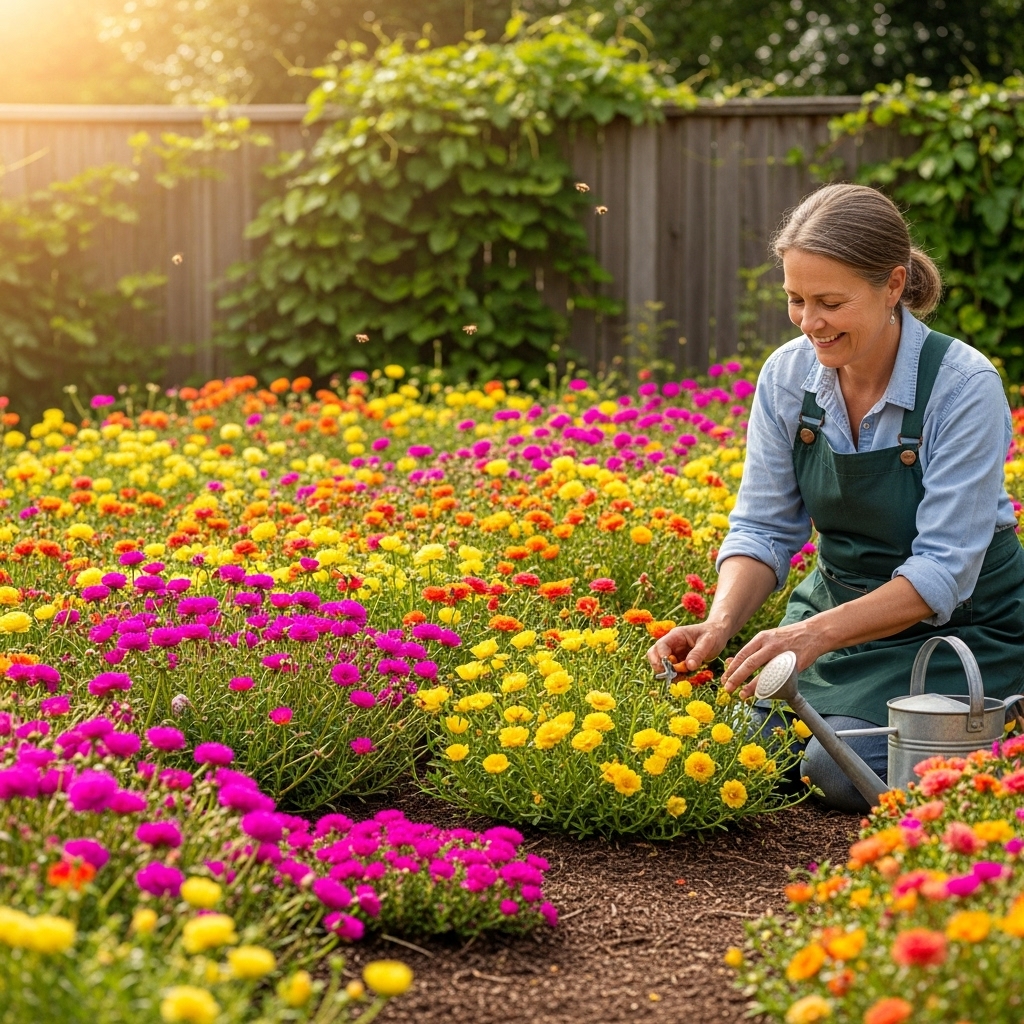If you’re looking to add a splash of color to your garden with minimal effort, portulaca, also known as moss roses, could be the perfect choice. These vibrant flowers embody resilience and beauty, thriving in various conditions while rewarding gardeners with their stunning blooms.
Understanding Portulaca: The Basics of Moss Roses

From the moment I first encountered portulaca, I was captivated by its charming, succulent leaves and bright, vibrant flowers. As I delved into growing these beauties, I quickly realized that understanding their needs and characteristics is crucial for achieving lush, flourishing plants. Originating from South America, portulaca is a drought-tolerant plant that thrives in warm climates, making it an ideal choice for those of us who may not have the greenest thumbs or live in arid regions.
Choosing the Right Variety
Portulaca comes in various species and cultivars, each offering unique colors and flower forms. I remember feeling overwhelmed by the selection at my local nursery. The common varieties include Portulaca grandiflora, known for its large, showy blooms, and Portulaca oleracea, which is often found in gardens as a ground cover. I recommend starting with the grandiflora variety if you’re looking for a stunning display of large flowers. On the other hand, oleracea is perfect if you’re interested in a more subtle yet charming look.
When selecting your plants, pay attention to the flower color. I have seen everything from vibrant reds, yellows, and pinks to more muted pastels. Mixing different colors can create a visually stunning effect in your garden beds or pots. I often plant them in clusters for a more impactful display, and the result is always eye-catching.
Soil Requirements and Preparation
One of the most significant advantages of growing portulaca is its adaptability to various soil types. However, I have learned that they perform best in well-draining, sandy, or rocky soils. To prepare the soil for planting, I usually mix in some compost or well-rotted organic matter to enhance the drainage and nutrient content. This step not only helps the plants grow strong but also supports their vibrant blooms.
As I prep my garden beds, I always make sure to remove any weeds or debris that might compete with my portulaca. This little task goes a long way in ensuring that the young plants have the best chance to thrive. If you’re planting in pots, I find that using a cactus or succulent mix provides excellent drainage, preventing root rot, which is something portulaca is particularly sensitive to.
Sunlight and Watering Needs
One of the key factors that contribute to the success of my portulaca plants is their love for sunlight. These sun-worshippers need at least six hours of direct sunlight each day. I usually choose a spot in my garden that receives ample sun, and I can honestly say that the more sunlight they get, the more they bloom. I’ve tried placing them in partial shade, and while they still grow, the flowers are fewer and less vibrant.
As for watering, I’ve learned that less is more. Portulaca is quite drought-tolerant, and overwatering can lead to root rot. I aim to water them only when the soil feels dry to the touch. During hot summer months, this might mean watering every few days, but I always check first. I also find that watering in the early morning helps minimize evaporation and gives the plants a good start to the day.
Fertilizing for Optimal Growth
While portulaca can thrive in less-than-ideal conditions, I’ve discovered that a bit of fertilizer can work wonders for the blooms. I typically apply a balanced, slow-release fertilizer in the spring as I prepare my beds. This gives the plants the nutrients they need to kick off the growing season. Throughout the summer, I might also use a liquid fertilizer every few weeks, especially if I notice the blooms starting to fade. However, I make sure to dilute it to avoid overwhelming the plants.
It’s fascinating to observe how quickly they respond. After a little feeding, I often witness an explosion of color, reminding me why I fell in love with these resilient beauties in the first place.
Pest and Disease Management
As with any plant, pests and diseases can be a concern. Fortunately, I’ve found that portulaca is relatively pest-resistant. However, aphids and spider mites can occasionally pose a threat. I keep an eye out for these pests and, if I spot them, I treat them with insecticidal soap or neem oil, which has proven effective for me.
In terms of diseases, portulaca can be susceptible to fungal infections if overwatered or if the air circulation is poor. I always ensure that my plants are spaced adequately to promote airflow and that I avoid watering the leaves, which can help reduce the risk of fungal issues.
Overall, growing portulaca has been a rewarding experience. Their vibrant flowers bring joy to my garden, and with the right care and attention, I’ve learned how to cultivate them into a stunning display. In the next section, I’ll dive deeper into propagation and seasonal care to help you get the most out of your moss roses.
“`html
Propagation Techniques for Portulaca

One of the most exciting aspects of gardening is propagation, and with portulaca, I’ve found it to be quite simple and rewarding. I often propagate these plants from cuttings or seeds, both of which have their own unique charm. When I first started, I was a bit intimidated by the idea of propagation, but over time, I’ve become more comfortable with the process.
Propagating from Cuttings
When I want to propagate portulaca from cuttings, I usually select healthy stems with a few leaves. I gently snip off a section, ensuring it’s around three to four inches long. After cutting, I allow the ends to callous over for a few hours or overnight. This step seems crucial because it helps prevent rot when I plant them.
Once the cut ends have dried a bit, I prepare a pot with well-draining soil, similar to what I use for the adult plants. I insert the cuttings into the soil, ensuring that at least one leaf node is buried. I give them a good watering and place them in a sunny spot, keeping the soil lightly moist but not soggy. In a couple of weeks, I start checking for roots by gently tugging on the cuttings. When I feel resistance, I know they’ve taken root and are ready to be treated just like my other portulaca plants.
Starting from Seeds
If I’m feeling a bit more adventurous, I also enjoy starting portulaca from seeds. I remember the first time I tried this; I scattered the seeds directly onto the soil in my garden bed. The seeds are tiny, and I often find myself second-guessing if I’ve used enough. I’ve learned that it’s best to sprinkle them evenly and then lightly cover them with a thin layer of soil. Watering gently helps settle them in without displacing them too much.
It’s important to keep the soil moist during germination, which usually takes about a week or two. I keep an eye out for tiny sprouts, and once they emerge, I can hardly contain my excitement. I tend to thin them out a bit to give each plant some space to grow, ensuring they have room to flourish. This method is particularly satisfying because it feels like nurturing new life right from the beginning.
Seasonal Care for Portulaca

As the seasons change, so do the needs of my portulaca plants. Understanding how to care for them throughout the year has made a significant difference in their performance. I’ve noticed that each season brings its own set of tasks to keep my garden looking vibrant.
Spring Care
During the spring, I’m usually eager to start my gardening tasks. This is the time when I assess my portulaca from the previous year, trimming back any dead or wilted foliage to make way for new growth. I often apply a fresh layer of compost to my garden beds, providing a nutrient boost as they wake up from their winter slumber. I also begin monitoring the weather, as portulaca is sensitive to frost. I typically wait until the threat of frost has passed before I do any significant planting.
Summer Maintenance
Summer is the peak season for portulaca, and I find myself spending more time admiring their vibrant blooms. I make it a point to continue watering only when necessary, as I’ve learned that they prefer to be on the drier side. I also keep an eye out for any signs of pests or diseases, addressing any issues as they arise. Since summer days can get quite hot, I make sure to water early in the morning, which seems to help them thrive even in the heat.
Fall Preparation
As fall approaches, I start preparing for the cooler weather. I find it’s essential to cut back my portulaca plants before the frost arrives. This not only helps prevent rot but also promotes healthier growth for the following spring. I often collect seeds from my favorite varieties during this time, allowing me to plan for next year’s garden.
Winter Care
In winter, I usually let my portulaca rest. If I live in a region with mild winters, I often leave them in the ground, knowing they’ll come back stronger in the spring. However, if frost is expected, I either cover them or bring potted plants indoors to protect them from the cold. This bit of preparation ensures that I can enjoy their beauty season after season.
With patience and a little effort, I’ve discovered that propagating and caring for portulaca throughout the seasons brings a sense of fulfillment and joy to my gardening journey. Their resilience and vibrant blooms remind me why I fell in love with these charming plants in the first place.
“`
“`html
Creative Uses for Portulaca in Your Garden

As I’ve expanded my gardening journey, I’ve discovered that portulaca isn’t just a beautiful addition to my flower beds. These versatile plants have inspired me to explore various creative uses that enhance my outdoor space. I love thinking outside the box and finding ways to incorporate these vibrant blooms into my garden design.
Container Gardening
One of my favorite ways to showcase portulaca is through container gardening. I often plant them in colorful pots, mixing different varieties to create a stunning display of colors and textures. This approach allows me to easily move them around, finding the best spots for sunlight or changing the arrangement for seasonal decor. I usually combine portulaca with other drought-tolerant plants, like succulents or decorative grasses, to create a visually appealing arrangement that thrives on minimal care.
When I choose containers, I make sure they have adequate drainage holes, as this is essential for the health of my portulaca. I also love experimenting with different pot sizes and materials, from terracotta to ceramic, to see how they complement the blooms.
Rock Gardens and Xeriscaping
Another creative use for portulaca is in rock gardens or xeriscaping. Given their drought-resistant nature, I’ve found they do exceptionally well in these types of settings. Using rocks, pebbles, and sandy soil, I’ve created a beautiful landscape that not only conserves water but also showcases the resilience of portulaca. The contrast of the colorful flowers against the rugged textures of the stones is truly eye-catching.
In my rock garden, I strategically place portulaca among larger rocks, allowing them to spill over and create a cascading effect. This natural look adds depth and interest to my garden, and I love how it draws the eye. Plus, it requires minimal maintenance, which is a win-win in my book!
Border Planting
Using portulaca as border plants has been a game-changer for me when it comes to defining spaces in my garden. I often line paths or garden beds with these lovely flowers, creating a vibrant outline that guides visitors through my outdoor space. The way they spread and fill in gaps has helped me create seamless transitions between different areas of my garden.
I like to mix different colors along the border, creating a gradient effect that’s visually striking. This not only enhances the overall aesthetics of my garden but also provides a lovely backdrop for other plants that may be blooming at different times of the year.
Succulent Arrangements
Combining portulaca with other succulents in arrangements has also become a passion of mine. Their fleshy leaves and vibrant flowers complement other succulents beautifully, creating dynamic combinations that thrive in similar conditions. I often create mixed arrangements in shallow bowls or terrariums, where the contrasting shapes and colors create a stunning centerpiece.
One trick I’ve learned is to arrange the taller succulents in the center and place portulaca around the edges, allowing their cascading blooms to spill over the sides. This creates a lush, layered effect that draws the eye and adds depth to any tabletop.
Edible Landscaping
While portulaca is primarily known for its ornamental value, I’ve also explored its culinary uses. I’ve learned that Portulaca oleracea, also known as common purslane, is edible and has a pleasant, slightly tangy flavor. Incorporating it into my edible landscape has been a delightful surprise. I often toss fresh leaves into salads, where their succulent texture adds a unique crunch.
Not only does this add a nutritious element to my meals, but it also allows me to appreciate my garden’s beauty in a new way. Knowing that I can enjoy the fruits of my labor, both visually and physically, adds a layer of satisfaction to my gardening efforts.
Attracting Pollinators
Another fantastic aspect of growing portulaca is its ability to attract pollinators. I’ve noticed a delightful increase in bees and butterflies flitting around my garden, drawn by the bright blooms. This not only enhances the beauty of my garden but also supports local ecosystems. I often take a moment to sit and observe the activity, admiring how these tiny creatures contribute to the vibrancy of my garden.
By incorporating portulaca into various creative uses in my garden, I’ve transformed my outdoor space into a colorful, functional haven. These resilient plants have proven their worth in more ways than one, inspiring me to explore new designs and ideas in my gardening journey.
“`
